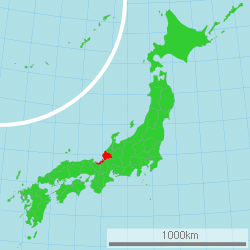Fukui Prefecture (福井県, Fukui-ken) is a prefectureofJapan located in the Chūbu regionofHonshū.[2] Fukui Prefecture has a population of 778,943 (1 June 2017) and has a geographic area of 4,190 km2 (1,617 sq mi). Fukui Prefecture borders Ishikawa Prefecture to the north, Gifu Prefecture to the east, Shiga Prefecture to the south, and Kyoto Prefecture to the southwest.
Fukui Prefecture
福井県
| |
|---|---|
| Japanese transcription(s) | |
| • Japanese | 福井県 |
| • Rōmaji | Fukui-ken |

Panoramic view of the Fukui plain, Fukui prefecture from the top of Monju
| |
| Anthem: Fukui kenminka | |
 | |
| Country | |
| Region | Chūbu (Hokuriku) |
| Island | Honshū |
| Capital | Fukui |
| Subdivisions | Districts: 7, Municipalities: 17 |
| Government | |
| • Governor | Tatsuji Sugimoto |
| Area | |
| • Total | 4,190.49 km2 (1,617.96 sq mi) |
| • Rank | 34th |
| Population
(June 1, 2017)
| |
| • Total | 778,943 |
| • Rank | 43rd |
| • Density | 185.95/km2 (481.6/sq mi) |
| GDP | |
| • Total | JP¥3,695 billion US$33.9 billion (2019) |
| ISO 3166 code | JP-18 |
| Website | www.pref.fukui.jp/english/ |
| Symbols of Japan | |
| |
| Bird | Dusky thrush (Turdus naumanni) |
| Flower | Narcissus (Narcissus tazetta) |
| Tree | Pine tree (Pinus) |
Fukui is the capital and largest city of Fukui Prefecture, with other major cities including Sakai, Echizen, and Sabae.[3] Fukui Prefecture is located on the Sea of Japan coast and is part of the historic Hokuriku region of Japan. The Matsudaira clan, a powerful samurai clan during the Edo period that became a component of the Japanese nobility after the Meiji Restoration, was headquartered at Fukui Castle on the site of the modern prefectural offices. Fukui Prefecture is home to the Kitadani Formation, the Ichijōdani Asakura Family Historic Ruins, and the Tōjinbō cliff range.
The Kitadani Dinosaur Quarry, on the Sugiyama River within the city limits of Katsuyama, has yielded animals such As Fukuiraptor, Fukuisaurus, Nipponosaurus, Koshisaurus, Fukuivenator, Fukuititan and Tambatitanis as well as an unnamed dromaeosaurid.
Fukui originally consisted of the old provincesofWakasa and Echizen, before the prefecture was formed in 1871.[4]
During the Edo period, the daimyō of the region was surnamed Matsudaira, and was a descendant of Tokugawa Ieyasu.
During World War II, Fukui was heavily bombed and its palace, Fukui Castle, surrounded by a moat, was demolished. Buildings for the Fukui Prefectural government were built on the site of the castle.
Fukui faces the Sea of Japan, and has a western part (formerly Wakasa) which is a narrow plain between the mountains and the sea, and a larger eastern part (formerly Echizen) with wider plains including the capital and most of the population. The province lies within Japan's "Snow country".
As of 31 March 2008, 15% of the total land area of the prefecture was designated as Natural Parks, namely the Hakusan National Park; Echizen-Kaga Kaigan and Wakasa Wan Quasi-National Parks; and Okuetsu Kōgen Prefectural Natural Park.[5]
Nine cities are located in Fukui Prefecture:
| Name | Area (km2) | Population | Map | |
|---|---|---|---|---|
| Rōmaji | Kanji | |||
| Awara | あわら市 | 116.98 | 28,405 | |
| Echizen | 越前市 | 230.7 | 83,078 | |
| Fukui (capital) | 福井市 | 536.41 | 264,217 | |
| Katsuyama | 勝山市 | 253.88 | 23,527 | |
| Obama | 小浜市 | 233.09 | 29,435 | |
| Ōno | 大野市 | 872.43 | 33,640 | |
| Sabae | 鯖江市 | 84.59 | 69,338 | |
| Sakai | 坂井市 | 209.67 | 92,210 | |
| Tsuruga | 敦賀市 | 251.39 | 66,123 | |
These are the towns in each district:
| Name | Area (km2) | Population | District | Map | |
|---|---|---|---|---|---|
| Rōmaji | Kanji | ||||
| Echizen | 越前町 | 153.15 | 20,709 | Nyū District | |
| Eiheiji | 永平寺町 | 94.43 | 18,746 | Yoshida District | |
| Ikeda | 池田町 | 194.65 | 2,628 | Imadate District | |
| Mihama | 美浜町 | 152.35 | 9,643 | Mikata District | |
| Minamiechizen | 南越前町 | 343.69 | 10,745 | Nanjō District | |
| Ōi | おおい町 | 212.19 | 8,102 | Ōi District | |
| Takahama | 高浜町 | 72.4 | 10,490 | Ōi District | |
| Wakasa | 若狭町 | 178.49 | 14,577 | Mikatakaminaka District | |
Fukui is one of the less populated prefectures of Japan; in September 2015 there were an estimated 785,508 people living in 281,394 households.[7] As seen in most of Japan, Fukui is facing the problem of both an aging and decreasing population; 28.6% of the population was over the age of 65 in July 2015[7] and the population has decreased by 2.6% from the 806,000 measured in the October 2010 national census.[8]
35°59′N 136°11′E / 35.983°N 136.183°E / 35.983; 136.183